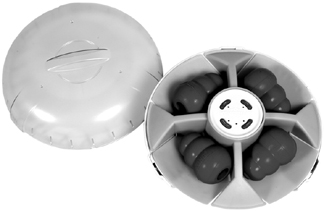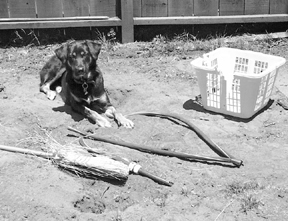Maybe I love KongTimeTM so much because it works wonders on a dog I love so much: Carly Hoye, my former-next-door neighbor’s dog. The Hoyes were my neighbors for seven years; their first dog, Sadie, was a frequent model for WDJ. The summer after Sadie passed away, the Hoyes went to a local shelter and brought home a nine-month old Shepherdy-sort of mix they named Carly.
Right off the bat, Carly was a doll, incredibly sweet and affectionate with the kids, bashfully compliant with adults, and playfully submissive to every other dog she met. The Hoyes signed her up for an adolescent dogs class, and Carly learned the basics of good manners training (plus a few cute tricks) very quickly.

There was only one fly in the ointment: As soon as the kids went back to school and Carly was left home alone during the day, things in and around the Hoye’s house began to get chewed. Initially, they thought it was just puppy teething, and to save the rugs and furniture (not to mention the hardwood floors and woodwork around the doors and windows in their restored Victorian) the Hoyes started leaving Carly outside during the day. But she soon advanced to chewing the lattice off the sides of the deck and the shingles off the sides of the house. She also chewed hoses and laundry baskets and any other random item she found in the yard. On the weekend, when the family was home, she continued to be an angel.
The dad, Dan Hoye, grew increasingly irritated with the destruction, but I hastened to explain that Carly’s behavior was not spiteful or some sort of “payback” for being left home alone. This was classic behavior for a dog who was experiencing separation anxiety. Carly was looking for things to do to keep herself busy and feel marginally better about being separated from her pack; it was stress relief.
Situation worsens
The mom, Maureen Hoye, was being very patient with Carly, and actively looking for solutions for managing the anxious dog. As she explained, “This was really the only thing we didn’t like about Carly; otherwise, she was the perfect dog for us.”
However, my explanations about separation anxiety didn’t reduce Dan Hoye’s frustration, especially when Carly added digging to her stress-relieving repertoire. She dug up plants and drilled holes in the lawn. She burrowed so enthusiastically next to the fence on the far side of her yard that she got the home-alone Labrador in that yard digging, too, and together they tunnelled into each other’s yards. Soon, long expanses of the wood fence between the yards began to sway and tip, as each post was undermined and loosened.
I advised the Hoyes to stop feeding Carly in a bowl, and start leaving her each day with a number of food-filled Kong toys, hidden in various places around the yard. This tactic worked brilliantly for a few days, but as Carly learned to hunt for and empty the Kongs more efficiently, it distracted her for only an hour or two. After unstuffing the Kongs, she would go back to work on the yard. Worst of all for me, the work-at-home neighbor, Carly started engaging in long barking sessions.
I had offered to provide daycare for Carly, and at this point, eager to avoid aggravating all the neighbors, the Hoye family took me up on my offer. On many days, Carly would come over and hang out with my dog and me in my office, which has a door to the backyard that I mostly keep open while I work, allowing the dogs to come and go as they please. We even removed a plank in the fence between our yards to facilitate an easy transfer.
The downside of this arrangement was that I’m not always home. Plus, I’m sure the Hoyes weren’t entirely comfortable with the thought of their dog spending many work days bonding with another family!
News of a potential solution
One day, at a photo shoot for an unrelated article, I happened to mention Carly and her family’s dilemma to Sandi Thompson, head trainer for Sirius Puppy Training in Berkeley, California. Thompson frequently models for the training articles in WDJ, and I enjoy talking about dog behavior with her. When I told her about Carly, Thompson grew excited. “She would be a perfect dog to test our invention,” she said.
That’s when I learned that Thompson and David Rucker, her engineer partner (another dog owner who sometimes consults for pet product makers), had dreamed up an idea for a machine that would dispense food-filled Kong toys to a home-alone dog. Rucker had built several prototypes of the machine and the couple was distributing them to a number of professional trainers and behaviorists for evaluation and testing.
That very day, they loaned me one of the prototypes – a large, unwieldy contraption with no resemblance to the machine’s current incarnation. The point was not how it looked; it was how and whether it would work to assuage a bored, anxious dog’s destructive and disruptive behavior.
That evening, I enthusiastically rushed the device over to my neighbors’ house, eager to share this new technology with them. The agreed to set up the machine so it would deliver four food-filled Kongs to Carly the next day.
As per Rucker and Thompson’s directions, they first operated the machine in “demonstration” mode in front of Carly, so she could hear the “preview” tone that precedes delivery of each Kong, and witness the toy itself rolling forth with its goodies inside. (Rucker added this feature to assuage concerns, expressed by some behaviorists, that a dog might wait anxiously all day in front of the machine, afraid to miss it eject a Kong. The tone is loud enough to alert a dog who has gone somewhere else in the house or yard, so the dog soon learns to be confident that the machine will let him know each time a Kong is about to emerge, and he will feel free to occupy himself elsewhere while waiting.)
The KongTime machine can be placed on the floor, or, if an owner is worried that her dog might spend an inordinate amount of time trying to get the Kongs out ahead of schedule, it can be placed on a counter or table. In this case, Rucker suggests that the owner run the machine on “demo” mode, to test the trajectory of the ejected Kongs. If they bounce or roll into a spot where the dog can’t get them, they can cause more anxiety!
A huge success
The Hoyes’ KongTime test went exactly as KongTime’s inventors intended. As Maureen Hoye recalls, “From the very first day, all of Carly’s destructive behavior stopped completely. She quickly learned that the tone meant a Kong was about to come out, and she’d go running toward the machine as soon as she heard it. Of course, it didn’t take her any less time than usual to unstuff the Kong, but she seemed to be content in between the Kong deliveries, knowing that more would arrive later. As far as I’m concerned, it was nothing short of miraculous.”
I was a more-than-interested witness to this miracle, with a front-row seat to Carly’s transformation. From my kitchen window, I could watch Carly in my neighbor’s backyard. Within days, she changed from an anxious dog who paced and dug and barked and chewed when home alone, to a bit of a couch potato. Almost every time I looked out the window, she was either lying on the Hoye’s deck or on the lawn, or chewing a Kong. Occasionally she’d get up to chase a squirrel out of the yard or along the top of the fence. Then she would lay down again. The Hoyes and I were both pleased, and a little surprised. It seemed almost too easy.

The Hoyes used the machine prototype for about two months, until its inventors needed it back. Carly completely stopped all her destruction and barking during that time, and we were all a little worried when we had to say goodbye to KongTime. The Hoyes went back to their original program of hiding food-filled Kongs all around the deck and yard when they left for work, and this time, that seemed to do the trick. Carly stayed destruction-free, with very minor, occasional exceptions.
Worth the wait
It’s a good thing for me and my neighbors that Carly’s problems seemed to be solved, since it took several years for Rucker and Thompson to finish the design process, obtain patents and financial backing, and begin production and distribution of the final incarnation of KongTime. Personally, I’ve been waiting rather impatiently, because I’ve been wanting to promote it in WDJ. I know so many home-alone dogs who would benefit from this tool.
Sadly for me, the Hoyes moved to another part of town. Carly had earned the privilege of spending her days in the house, sometimes with a sliding glass door open so she could go in and out as she wished. I no longer got to talk to her daily over the fence, or have her come over and visit. But the Hoye twins and my son are best friends, so I still see Carly periodically at the Hoyes’ house and at Little League games. And when they go on vacation, I get to dog-sit.
Curiously, Carly has been fine this whole time – no behavior problems despite being home alone all day during the school year. That is, until just a few months ago.
One day, Maureen called me to report that Carly had suddenly relapsed, causing hundreds of dollars of damage to their home. The boys came home from school and found the house in a shambles. The sliding glass door in the kitchen, which had been closed that day, was covered with slobber and footprints, to a height of six feet. All the vinyl window shutters in one section of the Hoye’s living room were chewed up. Several doors and door jambs throughout the house were scratched and gouged, apparently by nails and teeth. And the window-shades in Brendan’s room were chewed and knotted.
Maureen and I talked about the incident and tried to guess what might have set off what was clearly a sustained attempt on Carly’s part to get out of the house. Was she panicked? Or just bored? Since Carly does enjoy watching squirrels out the window, Maureen guessed that the dog might have been running from viewing spot to viewing spot, trying to get at the squirrels. “When is that darned KongTime going to be available for sale?!” Maureen asked me.
I called David and Sandi and learned that, coincidentally, they had just received the first units off the production line. They were nice enough to give one to the Hoyes that day – which also happens to be the last day Carly has wrecked anything.
It’s been about three months, and the Hoyes are still setting KongTime for Carly every day. Now that it’s on the market, they don’t anticipate ever going without the machine again. “At this point, it’s all about breaking up the monotony of her day,” says Maureen.
She also admits that when the family first got Carly, the young dog’s destructive behavior and barking was probably caused by separation anxiety, which the KongTime seemed to alleviate. This most recent outbreak, Maureen speculates, had more to do with boredom. “I think she invented a new game of ‘chasing’ the squirrels that she sees out the window from one window to the next, and she just got swept up in it,” says Maureen. “Reintroducing KongTime – in the nick of time! – broke the pattern.”
Sometimes, the Hoyes set KongTime for Carly on the weekends when they are home. “We like to watch her when we hear the preview tone,” says Maureen. “It’s fun, because she really does enjoy it. When she hears the tone, she runs to the kitchen and grabs the toy, gives it a flip or two to get the loose food out, and then takes it off to her bed or the backyard to work on emptying the sticky stuff.”
Not a sole solution
Despite its success in Carly’s case, Rucker and Thompson are quick to explain that no owner should depend on KongTime to provide the sole solution for a bored or anxious home-alone dog.
“We don’t want people to think Kong-Time is going to be a cure-all,” says Rucker. “A dog who is home all day by himself faces a number of challenges. We’re confident that KongTime will help, but we also feel that it’s best used as part of an overall program to alleviate all of the factors that cause a dog’s anxiety-related behavior.”
Helping the dog’s owner identify the potential contributors to the dog’s stress is where Thompson’s 20-plus years as a dog trainer come in handy. She frequently consults with dog owners on the phone, asking questions to help them analyze the situation. Has the owner stopped allowing the dog access to the outdoors? Has a new cat moved into the neighborhood, one who might be teasing the dog from atop a nearby fence? Is the dog battling a flea infestation or allergy that might be cranking up his discomfort?
All of these problems need to be addressed to effectively improve the dog’s behavior. As Thompson says, “KongTime is a useful supplement to anything and everything else the owners can do to reduce the dog’s tedium and isolation.”
Prevention role
Given Thompson’s long history teaching puppy classes, it makes sense that she would most like to see KongTime used for puppies in a preventive role, rather than as a fix for behavior problems that have resulted from a dog’s home-alone stress. “At some point, puppies have to be weaned from constant attention; eventually, most people have to go to work and leave their puppies home. In my opinion, KongTime is an ideal tool to give those puppies something to occupy themselves, and perhaps prevent boredom and stress-related problems from ever developing.”
Other trainers concur. Dana Cleveland, a trainer and the training and behavior manager for Citizen Canine, a daycare and boarding facility in Oakland, California, volunteered the dogs at her workplace as KongTime testers. “The dogs get good exercise here, but they do have a couple of periods a day when there isn’t much to do,” she says. “David and Sandi asked me to test KongTime in any way I saw fit, so I used it with several young, restless dogs who I thought might benefit from some extra fun and enrichment.”
Cleveland laughs, and then adds, “Also, frankly, I had doubts as to whether the machine would hold up to a couple of these dogs. I chose dogs that I thought might be able to break into and damage the machine; the most likely culprits included a couple of young Labradors, some known major chewers and food pigs.”
To her amazement, KongTime stood up to each of the six dogs Cleveland tested it with. “I gave it to one dog in particular, a seven-month-old Lab. I thought, if anybody has the ability and desire to bust into this machine, it will be this guy – but he never did! He just waited for the Kong, and then I’d see him on his bed, eating his Kong, wagging his tail. In fact, none of my test dogs tried to bust into it; they were just thrilled when the Kongs rolled out.”
All in all, Cleveland says she found KongTime to be a valuable tool for providing dogs with fun and enrichment. “I’d use it for any dog who was home alone for more than a couple of hours,” she says.
“I definitely recommend it to our clients, since many of the daycare dogs are here because they have such bad separation anxiety. KongTime gives them another tool in their toolbox for the times when daycare is not an option. It wouldn’t fix a dog who had very severe separation anxiety, but it’s ideal for the average home-alone dog, and to prevent boredom in home-alone puppies.”
I’m no trainer, but I’m obviously a believer. Consider KongTime for any anxious or under stimulated dog you know. You could really improve his or her life.
Also With This Article
“Many Uses of the Kong”
-Nancy Kerns is Editor of WDJ.







These are no longer available. Is there any other product out there like this?